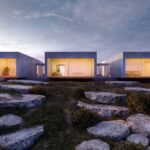Basic Elements of Architecture
In architecture, the basic elements serve as the foundation for creating functional, aesthetically pleasing, and meaningful structures. These elements—form, space, line, texture, and color—are the building blocks that architects use to shape our built environment. Understanding these elements is essential for appreciating architectural design and the impact it has on our daily lives. This article explores each element in detail.

1. Form
Definition and Importance
Form refers to the shape and structure of a building or any of its components. It is the three-dimensional outline that defines the volume of a space. Form is fundamental in architecture because it gives physical substance to a design, influencing both the exterior appearance and the interior spatial arrangement.
Types of Form
- Geometric Forms: These include regular shapes such as cubes, spheres, cylinders, and pyramids. Geometric forms are often associated with order, stability, and precision.
- Organic Forms: Inspired by nature, these forms are irregular, fluid, and dynamic. They are often used to create spaces that feel more natural and harmonious with their surroundings.
- Complex Forms: These are combinations of geometric and organic shapes, resulting in unique and intricate structures that challenge conventional design norms.
Examples in Architecture
- The Guggenheim Museum, New York: Designed by Frank Lloyd Wright, the museum’s spiral form creates a dynamic and continuous interior space.
- Sydney Opera House, Australia: The iconic sail-like forms designed by Jørn Utzon showcase the use of organic shapes in a landmark building.
2. Space
Definition and Importance
Space is the void or volume within and around a building. It is what architects design to be occupied, experienced, and interacted with by people. Space can be physical (the actual area) or perceptual (how it is perceived and used).
Types of Space
- Positive Space: The area occupied by physical objects or structures.
- Negative Space: The empty or open areas around and between objects.
- Public Space: Areas accessible to everyone, such as parks, plazas, and streets.
- Private Space: Areas restricted to specific individuals or groups, such as homes and offices.
Examples in Architecture
- Fallingwater, Pennsylvania: Frank Lloyd Wright’s design integrates interior and exterior spaces, creating a seamless flow with the surrounding natural environment.
- The Louvre Pyramid, Paris: The glass pyramid by I. M. Pei transforms the public space of the Louvre’s courtyard, enhancing its visual and functional qualities.
3. Line
Definition and Importance
Line is a fundamental element in architecture that defines shapes, guides the eye, and creates visual interest. Lines can be actual (drawn or built) or implied (suggested by the arrangement of other elements).
Types of Line
- Horizontal Lines: Convey a sense of stability, calm, and restfulness. They are often used in floor plans and low-rise buildings.
- Vertical Lines: Suggest strength, growth, and aspiration. They are prominent in high-rise buildings and elements like columns.
- Diagonal Lines: Indicate movement, dynamism, and tension. They can create a sense of activity and excitement in a design.
- Curved Lines: Evoke fluidity, softness, and flexibility. They are often used in organic and contemporary designs.
Examples in Architecture
- Villa Savoye, France: Le Corbusier’s use of horizontal lines emphasizes the building’s connection to the landscape and its modernist aesthetic.
- The Shard, London: The vertical lines of this skyscraper, designed by Renzo Piano, accentuate its height and slender profile.
4. Texture
Definition and Importance
Texture refers to the surface quality of a building, both visual and tactile. It influences how a building feels to the touch and how it is perceived visually. Texture can affect light reflection, acoustics, and the overall sensory experience of a space.
Types of Texture
- Smooth Textures: Reflect light evenly, creating a sleek, clean, and modern appearance. Materials like glass, polished stone, and metal often have smooth textures.
- Rough Textures: Scatter light irregularly, adding warmth, character, and a sense of rustic or natural quality. Materials like brick, stone, and wood can have rough textures.
- Patterned Textures: Created by repeating elements or motifs, they add visual interest and complexity to a surface. This can include carved stone, tiled surfaces, and textured plaster.
Examples in Architecture
- Casa Mila, Spain: Antoni Gaudí’s use of rough stone textures and undulating surfaces creates a dynamic and tactile experience.
- Seagram Building, New York: The smooth, glass facade of this modernist skyscraper by Mies van der Rohe emphasizes its sleek and minimalist design.
5. Color
Definition and Importance
Color is a powerful element that influences mood, perception, and the overall atmosphere of a space. It can highlight architectural features, create contrast, and convey symbolic meanings.
Applications of Color
- Exterior Color: Enhances the building’s identity, complements its surroundings, and can reflect cultural or contextual significance.
- Interior Color: Affects the ambiance of a space, influencing feelings of warmth, coolness, spaciousness, or coziness.
Examples in Architecture
- La Muralla Roja, Spain: Ricardo Bofill’s use of vibrant colors in this housing project creates a striking visual impact and a unique identity.
- Fallingwater, Pennsylvania: Frank Lloyd Wright’s use of earthy tones integrates the house harmoniously with its natural setting.
Conclusion
The basic elements of architecture—form, space, line, texture, and color—are essential tools for architects to create functional, aesthetic, and meaningful spaces. By understanding and skillfully manipulating these elements, architects can design buildings that not only meet practical needs but also enrich our visual and sensory experiences. Through these elements, architecture continues to evolve, shaping the environments in which we live, work, and play.



